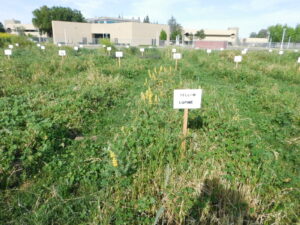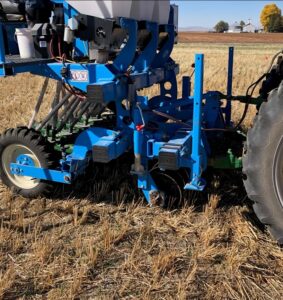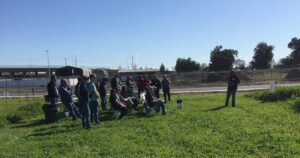Final report for EW17-014
Project Information
The NRCS Plant Materials Center (CAPMC) in Lockeford, CA serves as a research and education center for sustainable farming practices for California. California agriculture has struggled with low adoption rates for soil health practices such as conservation tillage, cover crops, and irrigation/nutrient management. The first phase will provide training at the CAPMC for NRCS, UCCE, and RCD conservationist in California. This training has been developed to include Cover Crop Selection, Planters, Seeding Rates and Species Identification, Weed Control, Pollinators, IPM, Organic Systems and Management Strategies. These professionals will then be invited to host a demonstration and training in their regions.
The long term goal of this project is to increase knowledge of cover cropping techniques and impacts of water and soil quality in order to increase the adoption rate of the practice in California. To achieve this goal, the following objectives will be met
Fall 2017 prepare for statewide training by planting cover crop demonstrations at the CAMPC. The objective of the preparation is to provide a full agenda of training to qualify for official NRCS training calendar.
- Spring 2018 statewide training to be held at CAPMC for conservationists and agriculture professionals. The objective of this training is to develop the technical knowledge of NRCS, UCCE, RCD and other agricultural professionals to understand and promote the use of cover crops.
- Fall 2018 work with conservationist on implementing regional demonstrations plots of cover cropping techniques learned at the CAPMC training. The objective of these demonstrations is to develop regional trainings for agricultural professionals and to further develop cover cropping techniques using CAPMC research results in different crops and climatic regions of California.
- Spring 2019 hold regional trainings at demonstration plots established in the fall to provide access to additional conservationists, UCCE, RCD and other agricultural professionals not able to attend previous training as well as farmers. The objective of theses trainings is to provide hands-on educational events to promote and understand the use of cover crops to improve water and soil quality.
Cooperators
- (Educator and Researcher)
- (Educator)
- (Educator)
- (Educator)
- (Educator)
- (Educator)
- (Educator and Researcher)
- (Educator and Researcher)
Education
Education & Outreach Initiatives
The objective of the preparation is to provide a full agenda of training to qualify for official USDA NRCS training calendar to provide a statewide training for agriculture professionals.
Fall 2017 prepared for statewide training by planting cover crop demonstrations at the CAMPC. Collaborated with USDA NRCS to develop training agenda that included topics relating to cover crops that would benefit agricultural professionals. Started collection of training materials and research material to include in training manuals which include materials from USDA, The Xerces Society, partners, industry and research.
Spring 2018 training held at the USDA Natural Resources Conservation Service Plant Material Center. Partner agencies throughout the state were invited to participate in a full day training on cover crops.
Topics included cover crop choices, maturation dates, mixture selections, weed control, pollinators and beneficial insects, IPM, management and termination strategies. 2018 Training Agenda Final
Training agenda was approved for USDA NRCS staff to attend to achieve job approval authority for Cover Crop (conservation practice 340). This level of training is typically only available to NRCS staff but will now be offered to UCCE, RCD and other agricultural professionals.
There were 43 attendees from USDA NRCS, University of California Cooperative Extension, Resource Conservation Districts, Tribal, Non-profits and Industry Leaders. 18 attendees receive Job Approval Authority from USDA NRCS to assist and certify cover crop practices for their area office.
Eight attendees expressed interest in providing demonstrations and workshops in their regions.
To provide regionally located cover crop demonstrations in farming systems that are regionally important to provide a training tool for agricultural professionals and farmers on adaptation of cover crops.
Summer 2018 began planning with 10 sites for regional demonstrations including Yuba City, 2 in San Diego, Redlands, Tulelake, 2 in Victorville, Fowler, Modesto and Salinas. 8 of the sites moved forward with planting winter cover crops in October 2018. Tulelake site was the only site not to germinate due to cold weather.
7 of the sites were used for cover crop workshops (6 with WSARE funding and 1 with partner funding). The below chart shows site location, crop type represented and seed mix used:
| Site | Crop Type | Seed Mix |
| Redlands | San Bernardino citrus orchard (Greenfield sandy loam, 8” annual precip.) | --34 lbs. of conventional clover mix (preferably treated with inoc.)
--2 lbs. of conventional daikon radish +Valerie (approx.) suggested Persian (25%), balansa (20%), berseem (20%), crimson (15%), rose (15%), daikon radish (5%)
|
| Modesto junior college | Urban grass plot | Variety of plots were planted to demonstrate the growth rates and weed/pest management. Included a clover mix, a mustard mix and a biomass mix. |
| Salinas - ALBA | Cover crop plot, but where lettuce, alfalfa and/or other row crops might grow | 45% ‘merced’ rye, 27.5% lana vetch, 27.5% purple vetch, at 160 lbs/ac
|
| Victorville – Jujube | Jujubes | 10 lbs. of organic red clover and 10 lbs. of organic crimson clover |
| Victorville – Row Crop | Radish, beet, squash, and others rotation | 12 lbs. organic Merced rye, 6 lbs. organic lana vetch, 2 lbs. organic yellow and white mustards |
| Fowler | Walnut orchard and a vineyard | 10ac in PAm Mustard Mix, 10ac in PAm Clover Mix, and 10ac in Lana vetch |
| Tulelake | Potatoes and onions | All numbers in lbs
Annual Ryegrass-2 Daikon Radish-2.5 · Frostmaster Pea-2 · Dutch White Clover-1 · Purple top turnip-3 · Riley Intermediate Ryegrass-2 · Organic Hairy Vetch-5.5 · Organic Merced Ryegrain-13 lbs
|
Demonstration sites provided a good regional representation of crop types, soil types and seed mixes for local partners and farmers/ranchers to see a cover crop implemented. Demonstration sites also brought together local and statewide partners to provide input on implementation which included USDA NRCS, local resource conservation districts, industry, and non-profits such as Xerces and project apis m.
Tours were offered to farmers, ranchers and partners that were interested in cover crops but unable to attend future field days. This resulted in many one-on-one consultations that could lead to future implementation and partnerships to do additional demonstrations and field days. Although there are no grants and projects to build upon these demonstrations at this time to report, ESRCD is confident that the right funding source and opportunity will present itself through established partnerships.


To proved regional cover crop trainings for professionals unable to attend the statewide trainings offered and farmers/ranchers access to the same level of training.
Post-planting for each demonstration site, the partners at each site worked on creating training materials and field day agenda. Started collection and copying of training materials and research material to include in training manuals which include materials from USDA, The Xerces Society, partners, industry and research.
Spring 2019 trainings held in Redlands, Salinas, Modesto, Victorville, and Fowler. Partner agencies and farmers from the region were invited to participate in the training on cover crops. Two of the workshops were offered in languages needed to address the local farming community (Korean in Victorville and Spanish in Salinas). 2-28_CoverCrop_flyer_Spanish Cover Crop Workshop Agenda March 2019
Topics included cover crop choices, maturation dates, mixture selections, weed control, pollinators and beneficial insects, IPM, management and termination strategies. 3-12_CoverCrop_flyerR Modesto cc workshop agenda
The regional demonstrations and trainings reached 143 professional and farmers at the trainings, an additional 93 consultations offered outside of the trainings, and 268 views since March 2019 of online training video. The long term impact of the individuals reached by this project will result in more implementation of cover crops in California.
Conservation professionals that attended the trainings have the knowledge needed to assist landowners in selecting a cover crop mix, communicate the benefits, and guide management decisions. The farmers that attended the trainings have expressed intent to use cover crops in the next year which will result in more implementation of cover crops.

